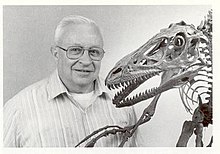John Ostrom
John Ostrom | |
|---|---|
 John Ostrom and Deinonychus skeleton cast. Photo courtesy Yale University. | |
| Born | February 18, 1928 |
| Died | July 16, 2005 (aged 77) |
| Nationality | American |
| Alma mater | Yale Columbia Union College |
| Known for | The "Dinosaur renaissance" |
| Scientific career | |
| Fields | Paleontology |
| Doctoral students | Robert T. Bakker |
John H. Ostrom (February 18, 1928 – July 16, 2005) was an American paleontologist who revolutionized modern understanding of dinosaurs in the 1960s, when he demonstrated that dinosaurs are more like big non-flying birds than they are like lizards (or "saurians"), an idea first proposed by Thomas Henry Huxley in the 1860s, but which had garnered few supporters. The first of Ostrom's broad-based reviews of the osteology and phylogeny of the primitive bird Archaeopteryx appeared in 1976. His reaction to the eventual discovery of feathered dinosaurs in China, after years of acrimonious debate, was bittersweet (Gentile, 2000).
Early life and career
He was born in New York City and studied at Union College. He planned to be a physician like his father, but changed his mind after reading George Gaylord Simpson's book The Meaning of Evolution. He enrolled at Columbia University and studied with Edwin H. Colbert.
In 1952 he married Nancy Grace Hartman (d. 2003) and had two daughters: Karen and Alicia.
Ostrom taught for one year at Brooklyn College and then spent five years at Beloit College before going to Yale. Ostrom was a professor at Yale University where he was the Curator Emeritus of Vertebrate Paleontology at the Peabody Museum of Natural History, which has an impressive fossil collection originally started by Othniel Charles Marsh. He died from complications of Alzheimer's disease at the age of 77 in Litchfield, Connecticut.
Warm-blooded Deinonychus
His 1964 discovery of Deinonychus is considered one of the most important fossil finds in history [1]. Deinonychus was an active predator that clearly killed its prey by leaping and slashing or stabbing with its "terrible claw". Evidence of a truly active lifestyle included long strings of muscle running along the tail, making it a stiff counterbalance for jumping and running. The conclusion that at least some dinosaurs had a high metabolism, and thus were at least partially warm-blooded, was popularized by his student Robert T. Bakker, and changed the impression of dinosaurs as cold-blooded, sluggish and slow lizards which had prevailed since the turn of the century.
This changed how dinosaurs are depicted by both professional dinosaur illustrators, and in the public eye. The find is also credited with triggering the "dinosaur renaissance", a term coined in a 1975 issue of Scientific American by Bakker to describe the renewed debates causing an influx of interest in paleontology, which has lasted from the 1970s to the present and has doubled recorded dinosaur diversity.
Archaeopteryx and the origin of flight, and hadrosaur herds
Ostrom's interest in the dinosaur-bird connection started with his study of what is now known as the Haarlem Archaeopteryx. Discovered in 1855, it was actually the first specimen recovered but, incorrectly labeled as Pterodactylus crassipes, it languished in the Teylers Museum in the Netherlands until Ostrom's 1970 paper (and 1972 description) correctly identified it as one of only eight "first birds" (counting the solitary feather).
Ostrom's reading of fossilized Hadrosaurus trackways also led him to the conclusion that these duckbilled dinosaurs traveled in herds.
References
- "At Last, His Theory Flies". May 5, 2000. Olivia F. Gentile. Hartford Courant.
- "Archaeopteryx". May 1975. John H. Ostrom. Discovery, volume 11, number 1, pages 15 to 23.
- Obituary Los Angeles Times July 21, 2005
